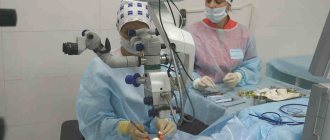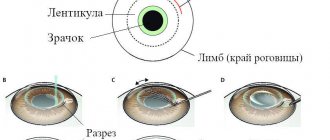What is astigmatism?
Mikhail Konovalov explains: “The eye is structured like a camera - it also consists of several lenses. One of the main lenses is the cornea - this is the superficial part of the eye, the transparent tissue. The cornea refracts rays, which then fall on the retina. Ideally, the cornea should be spherical, like a dome, and symmetrical. The vertical and horizontal axes of the cornea should be the same. If the cornea has an irregular shape, then eye astigmatism occurs - a phenomenon when one axis refracts light more strongly and the other weaker, so the beam of light hitting the retina is blurry. This defect can be corrected using: special cylindrical lenses, contact lenses or surgery. With the help of surgery, we make the cornea the way it should be - spherical. This is most often accomplished through refractive surgery using an excimer laser.”
Astigmatism. The program “Live Healthy”, says Prof. Konovalov
Release of the program “Live Healthy” dated September 15, 2010. (about astigmatism from 32 minutes of video)
Surgical correction of diseases
Many patients who have an advanced degree of myopic astigmatism and are coming to a specialist for the first time with this problem are afraid to hear about the need for surgery. This fear is due to ignorance of the essence of the surgical process and the risk of postoperative complications. That is why, before deciding on your own whether you need to agree to surgery, you should consult with several experienced ophthalmologists and weigh all the pros and cons of the upcoming eye surgery.
Today, surgical methods for treating eye diseases are more variable than ever. All of them have a number of indications for surgical procedures, as well as varying degrees of effectiveness. Let's look at the most effective among them.
Scleroplasty
Scleroplasty is understood as a type of operation during which transplantation materials, which can be biological, combined or synthetic, are placed on the surface of the sclera (under Tenon’s membrane). Subsequently, this material is either replaced or grows with newly formed connective tissue. The scar of connective tissue that forms during this process strengthens the sclera, preventing further stretching of the membranes of the eye, and also improves nutrition of the posterior pole of the eye due to the ingrowth of newly formed vessels. This type of surgical treatment is indicated for progressive myopia, with the risk of complications such as retinal detachment or vitreous opacification. With timely scleroplasty, the loss of vision stops, and subsequent laser vision correction procedures ensure its complete restoration.
Corneal surgical vision correction for myopia and astigmatism
Corneal (or corneal) methods for treating myopia include anterior radial keratotomy and myopic keratomileusis.
Keratotomy is based on making several non-through but deep incisions along the peripheral part of the cornea. Intraocular pressure causes swelling of the periphery of the outer wall of the eye, which, in turn, makes its central part flatter. This type of eye surgery has its disadvantages: due to surgical techniques on the cornea, its mechanical properties deteriorate, and, in addition, there is a high risk of increased intraocular abnormalities. The basis of myopic keratomileusis is based on the use of a special microtome on the superficial corneal layers: initially an incomplete section of the tissue is made, after which part of the deep-lying tissue is removed and the surface tissue is returned to its original position - this is how the central layers of the cornea are flattened. This type of eye surgery is recommended for myopia greater than 6 diopters and astigmatism.
Phakic intraocular lens implantation surgery
Lens refractive surgery involves the insertion of an artificial intraocular lens (positive or negative depending on the type of myopia) in front of the lens. This eye surgery is applicable for high degrees of myopia (up to 20 diopters) complicated by astigmatism, aged 18 to 45 years, and can have the following unpleasant consequences: hemorrhage, inflammation, retinal detachment, progression of clinical manifestations of astigmatism, lack of accommodation.
Transparent lens extraction surgery
Surgical removal of the clear lens and replacing it with an artificial intraocular lens is considered a highly effective option for correcting myopic disorders. International studies carried out in recent years among people over 40 years of age have shown that the majority of patients (89.5%) quickly returned to high visual acuity after extraction of the transparent lens, but along with it, clouding of the posterior capsule of the eye (Hayes) also rapidly developed. This indicates the possibility of side effects requiring careful postoperative treatment.
Types of astigmatism correction
Modern medicine offers 3 ways to correct astigmatism:
- wearing glasses,
- contact lenses
- and excimer laser correction.
Correcting astigmatism with glasses
For astigmatism, special glasses with complex cylindrical lenses are prescribed. This correction method may be associated with the appearance of unpleasant symptoms, especially in patients with a high degree of astigmatism: they often complain of dizziness, a feeling of pain in the eyes and visual discomfort.
Correcting astigmatism with contact lenses
Until recently, correcting astigmatism with lenses involved wearing uncomfortable hard contact lenses, but today special toric contact lenses are used to effectively correct astigmatism without discomfort.
Treatment of astigmatism with laser (astigmatism surgery)
Excimer laser correction of astigmatism (astigmatism surgery) is the only way to permanently get rid of this disease. Laser correction of the cornea using the LASIK method is performed under local drip anesthesia and takes no more than 10-15 minutes. And relatively recently, the latest laser correction method, FemtoLasik, has been used in the treatment of astigmatism.
Causes
Among the causes of mixed astigmatism are hereditary factors, general diseases of the body, eye surgery, and trauma. With such astigmatism, visible objects when viewed at different distances appear curved, without clear contours, and their size is difficult to determine. This happens because there are two types of refractive error in the eye at the same time: myopia is noted along one of the main eye meridians, and farsightedness is noted along the other. In other words, due to the uneven curvature of the corneal surface, one ocular meridian is hypermetropic and the other is myopic.
That is, with mixed astigmatism, the image is focused in the eye twice: partly behind the retina, partly in front of it. Thus, the single focus of light rays on the retina, necessary for clear vision, is simply absent. This kind of combination of two types of refraction in the eye creates serious difficulties for correcting the anomaly.
Why is astigmatism dangerous?
If a patient with astigmatism does not go to the clinic in time, this disease can cause strabismus and a sharp drop in vision. Astigmatism can also cause headaches and pain in the eyes.
Mikhail Konovalov: “Astigmatism is a very serious disease, especially in children. If a child has severe astigmatism, and it has not been corrected, then, as a rule, he then develops amblyopia. Amblyopia is a condition where even with further correction of astigmatism, we cannot achieve high vision. A person will never be able to see normally. Therefore, it is important to diagnose this disease and correct it, at least with banal glasses.”
Laser correction of astigmatism
Equipment for the diagnosis and treatment of astigmatism
For laser correction of astigmatism at the main stage of the operation, we use the WaveLight® EX500 . This is the latest generation model that provides excellent results for astigmatism correction. A flap from the upper layers of the cornea is formed using the French microkeratome Moria M2 Evolution (LASIK operation) or using the IntraLase iFS (FEMTO-LASIK operation), which has shown its high accuracy and efficiency when working with eyes of different anatomical structures, as well as in in the case of thin corneas, when a corneal flap of minimal thickness is required.
Preoperative diagnostics are carried out using the ALLEGRO Oculyzer , which examines the anterior segment of the eye and exports the obtained data via an internal network directly to the surgical excimer laser.
This makes it possible to perform the SuperLasik operation according to individual data, taking into account the structural features of each patient’s cornea. This operation allows you to obtain visual acuity of more than 100%, that is, “super vision”! The uniqueness of this technology is that it is performed without damaging the outer layers of the cornea, which makes its implementation during the postoperative period comfortable and absolutely painless. In some cases, the operation of choice for correcting high degrees of astigmatism in combination with myopia or high hyperopia is implantation of a phakic toric IOL or a multifocal toric phakic IOL (“contact lens inside the eye”). The advantage of this operation is that it does not affect the cornea, so it can be recommended for patients with thin corneas when laser correction is not possible. To correct astigmatism in elderly patients or patients with lens opacities, surgery to replace the clouded lens with an artificial toric intraocular lens (phacoemulsification of cataract with IOL implantation) may be recommended. In addition, in our Center it is possible to perform this operation with femtolaser support. This state-of-the-art technology allows using the LensX femtosecond laser to perform not only “knifeless” cataract surgery, but also to form incisions on the cornea to correct astigmatism, which, in combination with the implantation of a premium IOL, allows for the highest possible acuity and the best quality of vision after surgery.
Causes and symptoms of astigmatism
The causes of astigmatism lie in the disruption of the spherical surface of the cornea. Vision with astigmatism is unfocused, and the very name of this disease is translated as lack of focus of the visible image (a - negation, stigma - dot).
Causes of astigmatism:
- Optical feature of the structure of the cornea
- Changes in the shape of the cornea after eye injury
- Presence of scars on the cornea
- Consequences of inflammatory processes in the eyes (keratitis, erosion, corneal ulcer).
Symptoms of astigmatism in adults and children
:
- Blurred vision
- Ghosting
- Possibly headaches.











